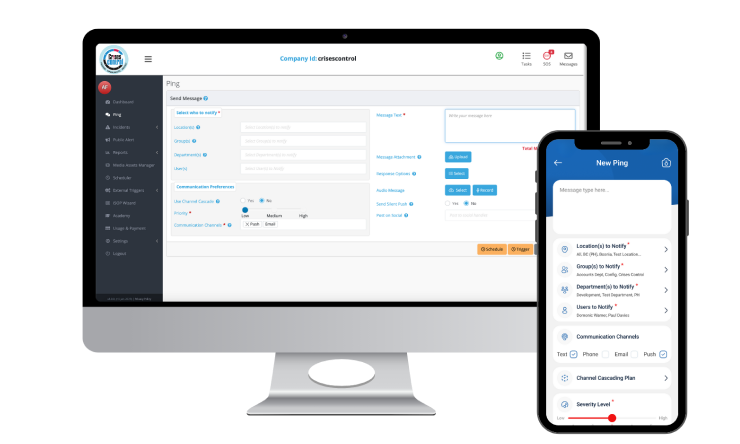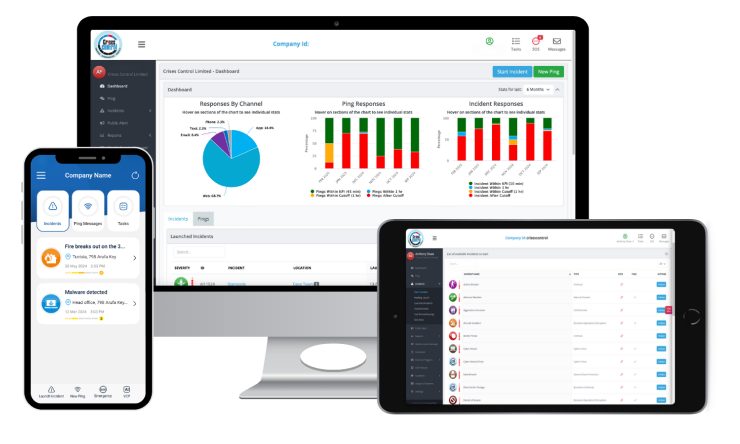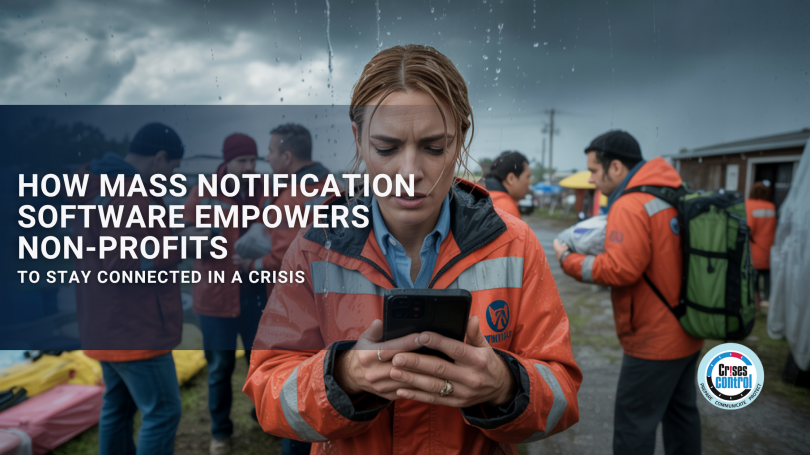Written by Anneri Fourie | Crises Control Executive
When a crisis strikes, non-profit teams are often on the front line, but they are not always equipped with the right tools to stay connected. A storm shuts down transport links, a data breach locks staff out of systems, or a key volunteer falls ill on the morning of a community event. In moments like these, coordination can unravel in minutes. Without clear communication, people are left guessing, services are delayed, and the trust that took years to build can be shaken overnight.
Reliable communication is not just an operational detail for non-profits, it is the backbone of continuity. Mass Notification Software helps ensure that when the unexpected happens, everyone knows what is going on, what to do next, and who needs help first.
Why Business Continuity Planning Matters for Non-Profit Organisations
Many non-profit organisations dedicate their resources to serving communities, supporting causes, and responding to urgent needs. Yet few have the same level of business continuity infrastructure as larger corporations. When an unexpected event occurs, whether a cyber incident, supply chain failure, or severe weather, these organisations must still keep critical operations running and maintain trust with staff, volunteers, donors, and beneficiaries.
A well-designed Business Continuity Plan (BCP) gives structure to that response. It identifies what is essential to keep operating, who is responsible for each part of the process, and what tools are needed to communicate and act quickly.
The challenge comes when the plan needs to be activated. Static documents and manual phone trees do not work effectively when time and clarity are critical. Mass Notification Software for non-profit organisations bridges this gap by connecting people instantly, ensuring that your continuity plan moves from paper to practice.
How Mass Notification Software Strengthens Business Continuity
At its core, Mass Notification Software is about one thing: getting the right message to the right people at the right time. It sends alerts across multiple channels, including SMS, email, mobile apps, and voice calls, reducing the risk of missed information or delays.
For non-profits, this is not simply convenient. It can make the difference between protecting people and pausing operations.
Here is how it helps:
- Multi-channel delivery: Alerts reach staff, volunteers, and partners instantly, no matter where they are or which device they use.
- Two-way communication: Recipients can confirm messages, report their status, or share updates, giving managers a clear view of who is safe and what still needs attention.
- Pre-set message templates: Common incidents such as IT outages or travel disruptions can be managed with one-click notifications, reducing response time and human error.
- Integration with incident management systems: Alerts can trigger automatically when an incident is detected, linking detection and action without delay.
A good notification system does not take over decision-making, it supports it. It helps leaders communicate clearly under pressure, make faster decisions, and ensure that their teams stay coordinated.
The Link Between Incident Management and Communication
When an incident occurs, communication is only one part of the challenge. Organisations also need to assess the impact, assign responsibilities, and monitor recovery. Without a structured process, communication can become fragmented. Emails go unanswered, calls are missed, and people work from different versions of the same information.
Integrated Incident Management Software plays a crucial role. By connecting communication tools and incident tracking within one system, teams can manage the entire lifecycle of an event in real time.
Platforms like Crises Control combine Mass Notification Software with incident management features, giving organisations a single source of truth during a crisis. Alerts can be triggered based on incident type, and updates shared automatically as the situation evolves. This speeds up response times and ensures every action is logged for compliance and review.
Real Scenarios: How Non-Profits Use Crisis Communication Tools
Real-world examples show why effective communication is at the heart of continuity.
1. Severe Weather Disruption: A charity running community programmes needs to pause operations due to flooding. With Mass Notification Software, leadership can send alerts to staff and volunteers within seconds, confirm their safety, and share instructions for relocating or pausing activities.
2. Cyber Incident: A donor database is compromised and access to key systems is restricted. The IT team can use Crises Control to issue alerts to management, volunteers, and external partners, coordinating the response and keeping everyone informed until systems are secure.
3. Volunteer or Staff Emergency: During a public event, a volunteer experiences a medical emergency. A quick alert to the on-site team ensures help is dispatched immediately, while managers receive real-time confirmation of the response.
Each of these situations shows how clear, instant communication protects both people and reputation.
Turning Continuity Plans into Action with Crises Control
A well-prepared plan is valuable, but it only works if it can be activated effectively. Crises Control is designed to help organisations put their plans into motion when disruption occurs. Its platform combines Mass Notification Software, Incident Management Software, and Business Continuity Planning tools in one easy-to-use system.
Here is how it supports non-profits in practice:
- Instant Activation: Pre-configured scenarios let you launch continuity plans in seconds.
- Global Reach: Multi-channel, multilingual alerts ensure every stakeholder stays informed.
- Custom Workflows: Adapt responses to your specific risks and organisational structure.
- Audit Trails and Reporting: Every action is logged for transparency and compliance.
- Mobile Accessibility: Volunteers and remote staff can send and receive updates directly from their phones, even if main systems are unavailable.
This combination of accessibility and control allows non-profits to respond to incidents quickly and confidently.
Interested in our Ping Mass Notification Software?
Efficiently alert everyone in seconds at scale with our Mass Notification Software.

Integrating Mass Notification Software into Your Business Continuity Plan
Building Mass Notification Software into your continuity strategy does not have to be complicated. What matters is taking a structured approach.
Here are five practical steps to start with:
- Identify critical contacts: Decide who needs to be notified first, and how quickly.
- Set up clear groups: Separate staff, volunteers, trustees, and partners to make targeted communication easy.
- Create message templates: Prepare alerts for the most likely scenarios, from power outages to cyber incidents.
- Train your team: Make sure everyone understands how to recognise and respond to official notifications.
- Test regularly: Run short simulations to make sure the system works as intended and to build confidence among users.
This approach turns your continuity plan from a static document into a working, real-time response framework.
Why Non-Profits Should Prioritise Mass Notification Systems
For non-profit organisations, reputation and trust are everything. In a crisis, how quickly and clearly your organisation communicates determines how confidently stakeholders will continue to support your mission.
Mass Notification Software provides three main benefits that support long-term resilience:
- Continuity of service: Keeps your operations running even when normal channels fail.
- Safety and accountability: Ensures every team member can be reached, acknowledged, and accounted for.
- Confidence and transparency: Shows donors, partners, and communities that your organisation can respond effectively to risk.
When people know that your organisation can act swiftly and communicate clearly, their confidence in your mission grows stronger.
The Future of Communication in the Non-Profit Sector
As the non-profit sector continues to modernise, communication will play an even greater role in resilience and accountability. The future of crisis management lies in automation, mobile-first engagement, and data-driven decision-making.
Platforms like Crises Control are already helping non-profits use real-time analytics and automation to detect, manage, and recover from incidents faster than ever before. Mass notification tools are no longer just about sending alerts, they are becoming complete continuity ecosystems that connect people, data, and processes in one place.
Take Control of Your Continuity with Crises Control
Non-profit organisations exist to make a difference, often under challenging conditions. When communication breaks down during a crisis, even the best intentions can be disrupted. Implementing Mass Notification Software is a practical way to protect your people, operations, and mission.
Crises Control gives non-profits the confidence to act quickly, keep teams informed, and maintain service continuity when it matters most. Whether you are creating a new Business Continuity Plan or improving your current one, the platform provides the tools to simplify response and strengthen communication.
Contact us today to book your free demo and discover how Crises Control can help your organisation stay connected, informed, and ready for whatever comes next.
Request a FREE Demo

